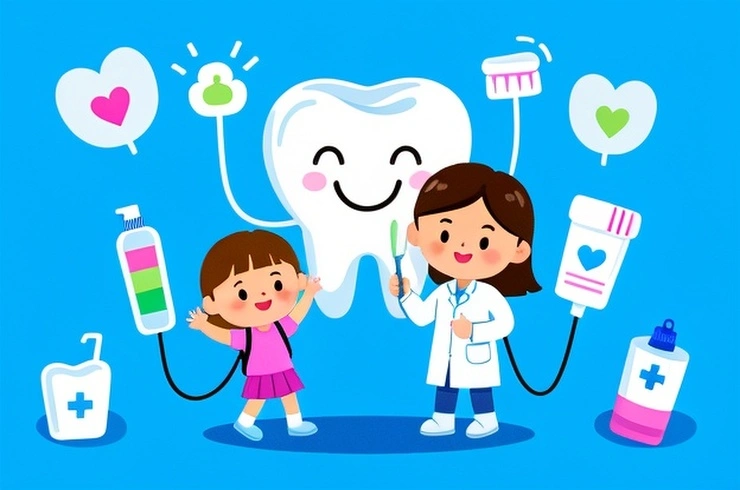
When you think of cavities, your mind might immediately go to the molars at the back of your mouth, hidden away and constantly at work grinding food. While these teeth are indeed common sites for decay, it's a misconception that your front teeth are immune. Despite their smoother surfaces and easier accessibility for cleaning, your front incisors – the teeth most visible when you smile – can also develop cavities without consistent and mindful oral hygiene.
Cavities on your front teeth pose both cosmetic and health concerns. Because of their prominent position, any decay can significantly impact your smile's appearance. Your family dentist will approach the treatment of front tooth decay with special care to address both the health of the tooth and its aesthetic.
What Causes a Front Tooth Cavity?
The culprits behind cavities in your back teeth are largely the same for your front teeth:
Sugary and Acidic Foods & Drinks: These, especially acidic sodas, create an environment ripe for decay-causing bacteria.
Food Particles: Bits of food lodged between teeth provide fuel for bacteria.
Poor Oral Hygiene: Forgetting to brush or skipping your daily flossing routine allows plaque to build up and acids to attack tooth enamel.
Acid Reflux: Stomach acid can erode tooth enamel, making teeth more vulnerable to decay.
Lack of Fluoride: Fluoride helps strengthen tooth enamel and make it more resistant to acid attacks.
In young children, a prevalent global condition known as Early Childhood Caries (ECC) or baby-bottle tooth decay (BBTD) significantly increases the risk of front tooth cavities. According to researchers, this is more common than any other condition in children. Untreated, these cavities can lead to serious dental problems and broader health issues.
Babies and young children are particularly susceptible to front tooth decay due to certain habits:
Sleeping with Bottles: Allowing a child to fall asleep with a bottle filled with sugar-sweetened drinks, milk, or even juice (even diluted) exposes their teeth to sugars for extended periods. This can also occur if a baby falls asleep while nursing.
Constant Sipping: Offering sugary drinks, milk, or juice in a bottle or sippy cup throughout the day creates a continuous sugar bath for their teeth.
Sharing Saliva: When parents share utensils or cups with their children, or clean pacifiers by putting them in their mouths, decay-causing bacteria can be transferred.
Did You Know? While sugar-sweetened drinks should always be avoided for children, milk and juice should be limited to mealtimes. Water is the safest and healthiest choice for children to drink throughout the day and before bed.
How to Identify and Treat a Front Tooth Cavity
Since you might not immediately realize you have a cavity, regular dental checkups every six months are crucial, as recommended by the American Dental Association (ADA). If you do spot a potential cavity on a front tooth, it's vital to see your dentist without delay to prevent the decay from worsening.
Visually, early decay often appears as white spots on the tooth surface, progressing to a light brown or gray discoloration. At these stages, professional dental care is essential before the tooth turns dark brown or black. You or your child might also experience pain or sensitivity to hot, cold, or sweet foods and drinks.
For permanent front teeth cavities, dentists typically remove the decayed portion of the tooth and then fill it with a strong, restorative material. To maintain a natural appearance, tooth-colored composite fillings, made from plastic resins and finely ground glass-like elements, are commonly used. This treatment usually requires just one dental visit.
For more significant cosmetic concerns arising from a front tooth cavity, your dentist might suggest restorative prosthetics:
Crown: A custom-made, tooth-shaped cap that covers the entire remaining tooth structure, matching your natural tooth color for a seamless look.
Veneer: A thin, custom-made piece of porcelain that is bonded to the front surface of the tooth, meticulously matched to your natural tooth color.
These cosmetic options generally require two or more dental visits. Your dentist will discuss the best treatment approach for your or your child's specific situation.
How to Prevent a Front Tooth Cavity
The excellent news is that preventing tooth decay, including cavities on your front teeth, is highly achievable with straightforward daily practices:
Brush Regularly: Brush your teeth twice a day using fluoride toothpaste.
Floss Daily: Engage in interdental cleaning (flossing) at least once a day to remove food particles and plaque from between teeth.
Balanced Diet: Consume a healthy, balanced diet, and significantly limit your intake of foods and drinks with added sugars.
Routine Dental Visits: See your dentist twice a year for professional checkups and cleanings.
By establishing and maintaining a consistent oral health care routine, you can significantly reduce your and your child's risk of tooth decay and ensure a healthy, vibrant smile throughout life. Remember to avoid sugary and acidic foods and drinks, and make brushing and flossing a daily habit.
This article aims to enhance understanding and knowledge about general oral health. It should not replace professional dental advice, diagnosis, or treatment. Always consult your dentist or another qualified healthcare provider with any questions about a medical condition or treatment.
Pro Tip
The content of the article is shared by netizens, please carefully identify it